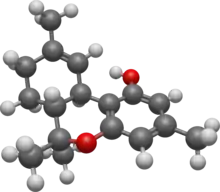Tetrahydrocannabiorcol
Δ9-Tetrahydrocannabiorcol (Δ9-THCC, (C1)-Δ9-THC) is a phytocannabinoid found in Cannabis pollen.[1] It is a homologue of THC and THCV with the alkyl side chain replaced by a smaller methyl group. Unlike THC and THCV, THCC has negligible affinity for the CB1 and CB2 cannabinoid receptors because of the smaller methyl group and does not have psychoactive effects as a result, but conversely it is significantly more potent than THC or THCV as an activator of the TRPA1 calcium channel which plays an important role in pain perception,[2] and it has been shown to produce analgesic effects via activation of spinal TRPA1 channels. [3][4]
 | |
 | |
| Identifiers | |
|---|---|
IUPAC name
| |
| CAS Number | |
| PubChem CID | |
| ChemSpider | |
| UNII | |
| Chemical and physical data | |
| Formula | C17H22O2 |
| Molar mass | 258.361 g·mol−1 |
| 3D model (JSmol) | |
SMILES
| |
InChI
| |
References
- Ross SA, ElSohly MA, Sultana GN, et al. "Flavonoid glycosides and cannabinoids from the pollen of Cannabis sativa L". Phytochemical Analysis. 16 (1): 45–8. doi:10.1002/pca.809. PMID 15688956.
- Bow EW, Rimoldi JM (2016). "The Structure-Function Relationships of Classical Cannabinoids: CB1/CB2 Modulation". Perspectives in Medicinal Chemistry. 8: 17–39. doi:10.4137/PMC.S32171. PMC 4927043. PMID 27398024.
- Andersson DA, Gentry C, Alenmyr L, et al. (November 2011). "TRPA1 mediates spinal antinociception induced by acetaminophen and the cannabinoid Δ(9)-tetrahydrocannabiorcol". Nature Communications. 2: 551. doi:10.1038/ncomms1559. PMID 22109525.
- Moparthi L, Survery S, Kreir M, et al. (November 2014). "Human TRPA1 is intrinsically cold- and chemosensitive with and without its N-terminal ankyrin repeat domain". Proceedings of the National Academy of Sciences of the United States of America. 111 (47): 16901–6. doi:10.1073/pnas.1412689111. PMC 4250169. PMID 25389312.
This article is issued from Wikipedia. The text is licensed under Creative Commons - Attribution - Sharealike. Additional terms may apply for the media files.